Republic of Chad
For this entry, we’re not going very far from our last entry; the Republic of Chad is a neighbor to the Central African Republic and, as you might expect, their cuisines are not wholly dissimilar. As we’ve seen with several of the African countries we’ve encountered, stews are a big deal, as well as a carbohydrate with which to convey said stew to one’s mouthhole. Unfortunately for me, the dearth of reliable recipes from Central Africa continues, and I had to make some educated conjectural leaps in formulating these recipes. You’ll see where I was successful and… erm, where I wasn’t.
Chad is and has been in a similar state as its neighbors for some time – it is classified as a failed state, and consistently ranks very high on the global index for political corruption; as an example, its president, Idris Déby, has been in power for over twenty-eight years, and his Parliament recently approved a measure that would allow him to remain in office through 2033. Poverty is endemic, and as with a number of other African states held back by the vestiges of European colonialism and civil war, civil and human rights abuses are frequent. With a government of cronies and self-serving tribal leaders, it is unlikely that any of these factors will change anytime soon.
I started my research much as I did with the Central African Republic, and I was lucky enough to find that this time there were several seemingly reputable Chadian sources available online. Though they were in French, there was enough to get me started on at least the basic skeletons of recipes. I was pretty sure I was in the clear.
Well, I wasn’t. Two out of the three dishes I planned to make worked out really well, but that third one… oof. Let me tell you about my fail.
Kissar (or kisser, or even kisra) is, in theory, a fluffy sourdough crepe that is steamed over low heat and used to sop up a stew or a sauce. The pictures I saw of them looked delicious – unfortunately, that’s as close as I got to encountering kissar, as whatever abomination I created was a far cry from the real thing. I watched several videos on kissar-making, and in each case it seemed identical to regular crepe-making – a nonstick pan or griddle, a flat object to spread the batter (usually a rectangular piece of palm leaf), and just a few seconds of cooking time. I was sure I had this in the bag.
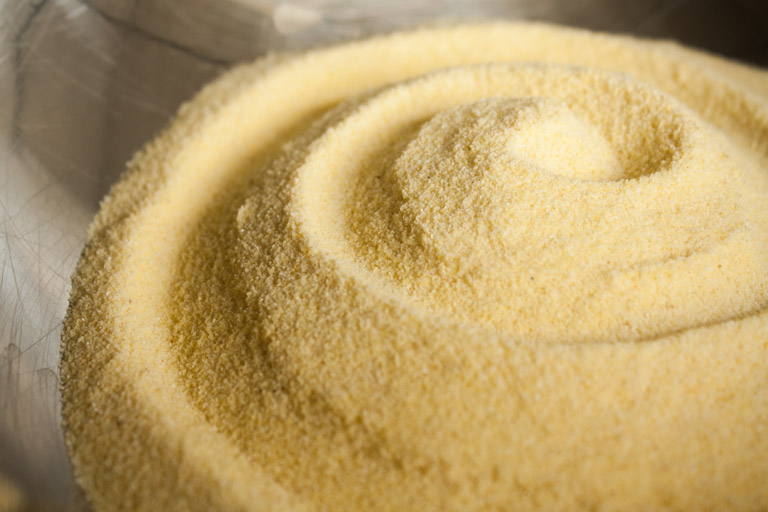
According to three different kissar recipes that I found, step one is to take some semolina flour and boil it in water for a few minutes. Unfortunately, as with recipes from the Central African Republic, all of the directions I found seem to have a common ancestor in one Ur-recipe, which states the following:
“dans une casserole, un 1/2 d’eau, amener à ébullition, puis ajouter 200g de sémoule en remuant avec un fouet 1 à 2 minites.”
I think the root of all of my issues was an inability to translate idiomatically from French – when I saw “un 1/2 d’eau,” I said “well surely there’s a word missing – un 1/2 of what? A liter? A cup??” Both of these were wrong, which meant that I was left with a hard lump of congealed dough, not a batter. I translated again in order to make another attempt, this time figuring that maybe it was referring back to the casserole – “a casserole half-full of water.” This time I checked a typical recipe for cream-of-wheat porridge, boiled about seven cups of water and tried again.

That’s more like it
It was a little on the wet side, but much better. To counter the wetness, I boiled to thicken as much as I could, longer than the directions noted, and then let this cream of wheat cool down completely. The next step was to whip in some yeast, more semolina flour and a bit of plain natural yogurt.
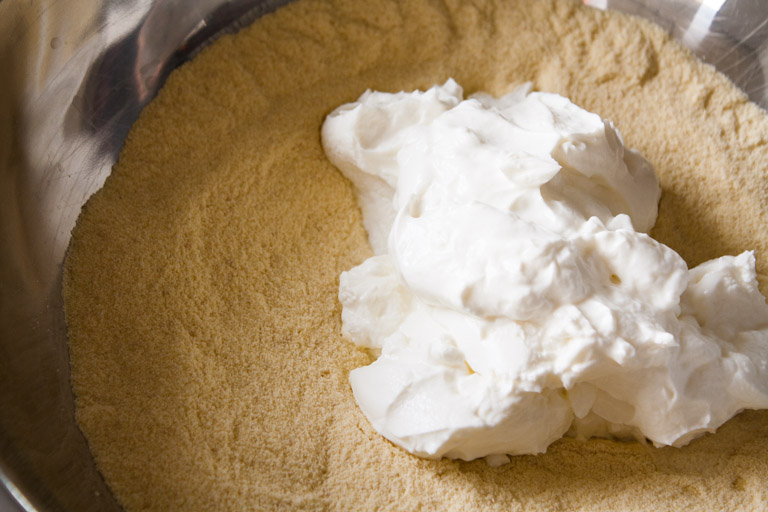
Once this is done, you end up with something that looks exactly like pancake batter:
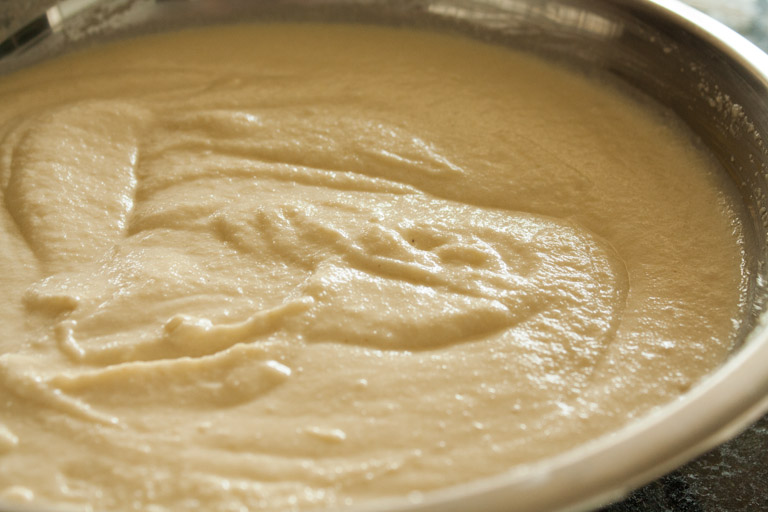
The rest should be easy – you just let it ferment and rise overnight, and the next day you whisk in some sugar and get cooking! I thought for sure I had resolved the issues. I mean, take a look at the bubbles! The fermentation worked just fine, although it did smell an awful lot like very yeasty beer:
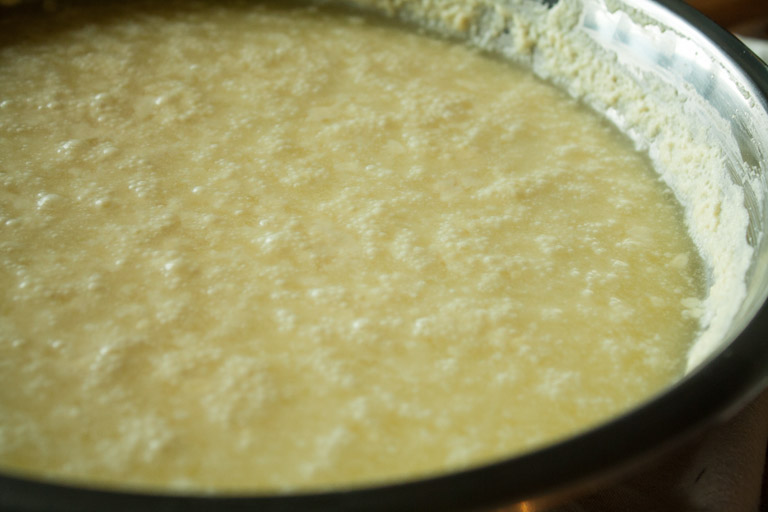
I worked granulated sugar into the batter and let it sit for just a bit longer. Finally, it was time to start cranking out pancakes. I lightly oiled a pan, per the directions, and cooked on low heat for a few minutes until bubbles started to form and the batter began to give off a strong, sour, bready aroma.

The directions were specific about not letting these crepes brown at all – much like Ethiopian injera, these are soft, fluffy crepes, more like a steamed flatbreads than “pancakes,” really. Unfortunately, no combination of cooking them covered, uncovered, a little of both, high heat, low heat, or medium heat yielded any success… nothing worked. I tried about fifteen of them and every single one crumpled at the slightest touch.
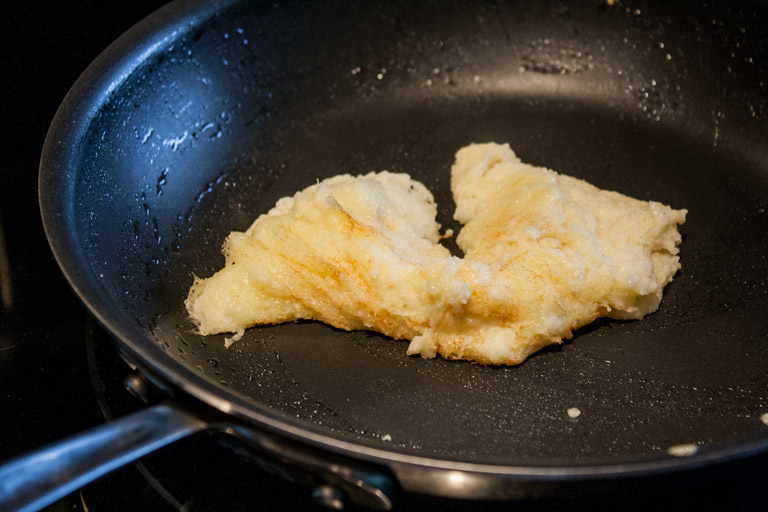
Forgive me Father for I have sinned
For whatever reason, these fragile little crepes had not developed any gluten or protein structure during their night-long fermentation and rise. The batter simply would not stay together – I suspect that I maybe used TOO much water for the batter on this attempt. As has happened in the past, without a clear recipe with standardized measurements (how big is “une casserole“??), there was no way to know for sure. They also tasted very sour, of yeast and nothing else, and were a bit unpleasant. Maybe too much yeast, as well. I had to let this one die. Rice would have to do.
Luckily, the rest of the dishes went much better – the first was an awesome vegetable stew thickened with peanut butter, which is called daraba. The seasonings, as usual, are very simple: just salt, pepper, and piment. This time I opted for dried red pepper powder instead of fresh chilies, which gave a nice background heat. The rest is just some good-quality veggies, like okra, spinach, eggplant, tomatoes, and sweet potato.
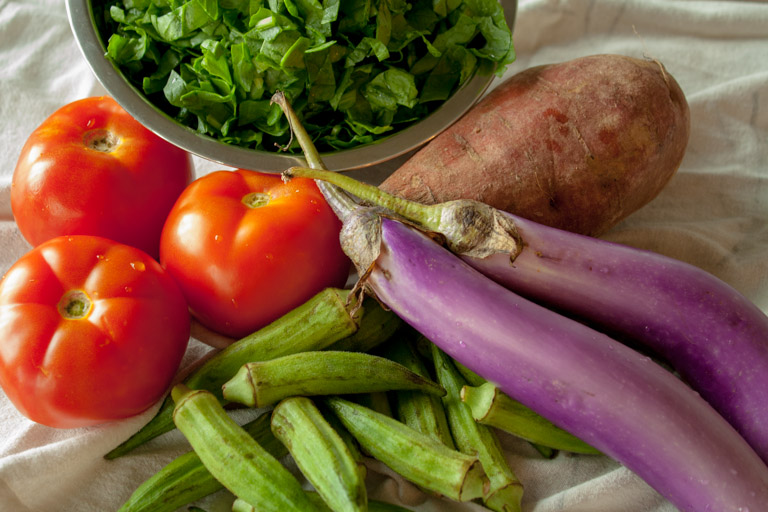
There’s not even any onion or garlic in this dish! Just chop up the veggies, throw them in a pot to boil, and be patient. We’re trying to coax the goopiness out of the okra, which is why they are chopped and not left whole. The gloppy slime that they give off will help the stew adhere to our carbohydrate of choice (which is a big help when you are eating with your hands).
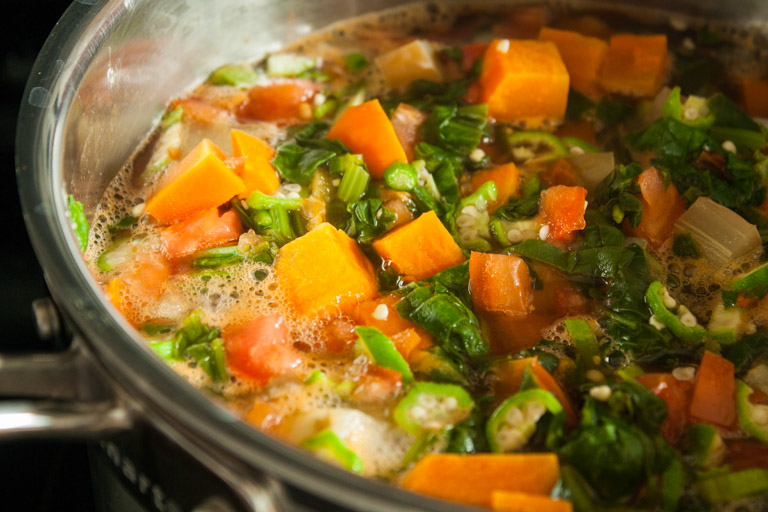
This stew really smells like a fresh garden, and the fragrance of the okra is so intensely green it really makes this stew feel healthy and nutritious. While that was boiling, I prepped the ingredients for our other dish, another slimy stew known as mouloukhié. This time we’re using onions and garlic to stew some beef, which should be somewhat fatty since there is not much else going into the pot along with it.
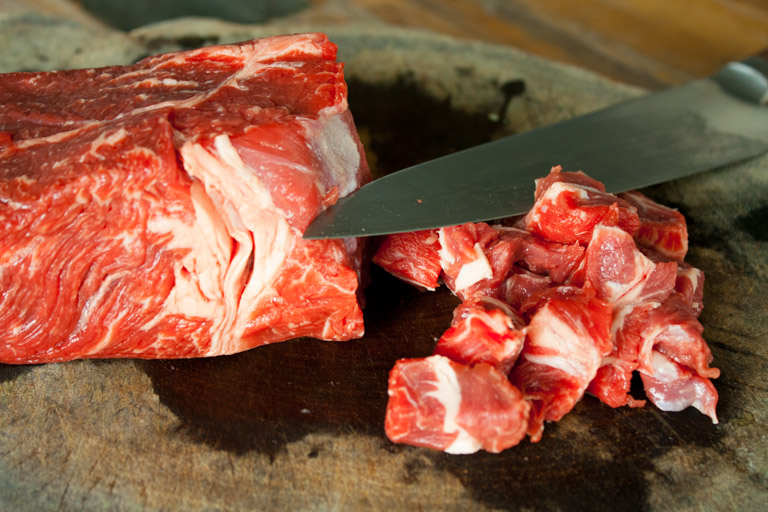
To these ingredients we also add the stew’s namesake – about one pound of frozen leaves of the jute plant, Corchorus olitorius, known to many in Africa and the Middle-East as molokhia. These are not a typical crop in the U.S., but luckily they are loved in many countries and therefore were handily sourced at my local Asian grocer. They appear in recipes in Chad and Sudan (sometimes in powdered form), and to my mind are an obvious and direct result of the Middle-Eastern presence and influence that has also led to an overwhelming Muslim majority in these countries. (A similar soup featuring molokhia is considered one of the national dishes of Egypt, for example.)

You just thaw them out and save the thick, viscous liquid in which they are packed – this will give body and flavor to the stew which, like our daraba, we want to adhere easily to bread or rice or ugali/fufu.

If you can imagine a fusion of spinach and okra in one plant, this would be it – very mucilaginous, and without much fragrance in the raw, frozen version. This gets finely chopped and added to the stewpot with the beef to simmer for a good while.
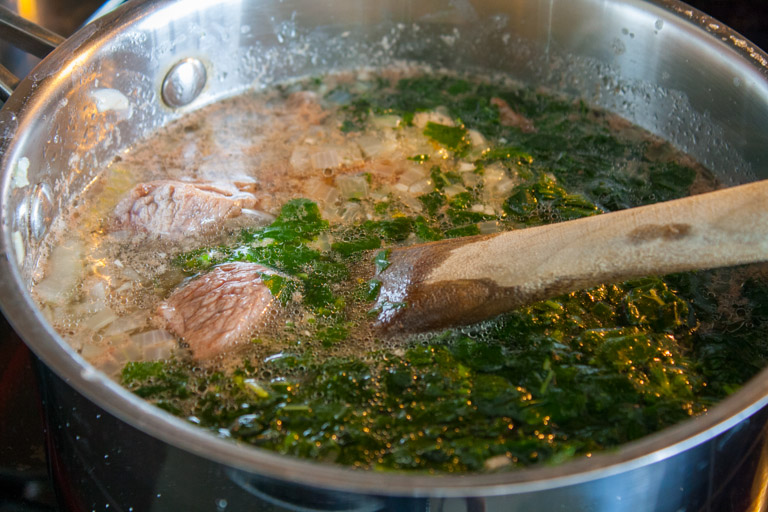
As the stew simmers, the jute leaves give off a shrimpy smell – some kind of iodine-like vapor that recalls boiled shrimp instantly. As it cooks, this aroma gives way to deeper, bitter, darker, more savory smells. After about an hour, the stew was nicely reduced and ready to eat.

Here we have another very simple Central African stew that is SO DELICIOUS. The previously tough beef is now fall-apart tender, and the stew itself, thickened by jute goop, seems impossibly rich due to the complex flavors lent by the molokhia leaves. It’s slimy, but not upsettingly so (if you’ve ever had a bowl of gumbo you would be well within your comfort zone), and those vaguely seafood-y aromas and flavors make it seem like much more has somehow happened in just an hour of simmering. It’s grassy, slightly bitter, and deeply savory – I even checked a botany report on this plant just to see if it was natural producer of MSG, but it does not appear to be. Could have fooled me – it’s like kale with less sulphur, or spinach crossed with shrimp. Just excellent.
This stew also made a great partner to our daraba, which was finished with a bit of natural peanut butter and thickened with just a few more minutes on the heat:
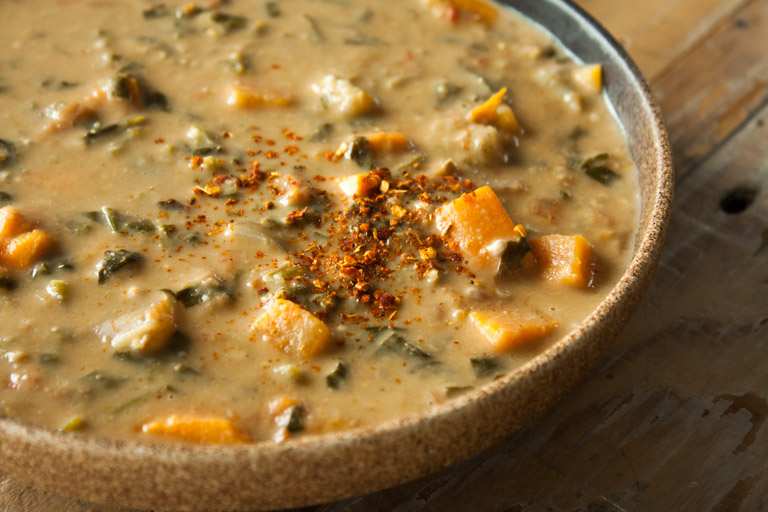
The veggies in this stew have given up all they had to the broth, and the peanut butter makes it smooth, creamy and a little gloppy. It’s full of rich flavors and the sweetness of the veggies really stands out, along with the peppery flavor of the okra – I found myself moving back and forth between the two stews, with a bite of rice in between, and even groaning happily a few times.
Chad, you deserve more attention for your food, and I’m just glad that there are moms and grandmas out there who can make kissar better than I can. Thanks for letting me give it a shot – I hope I did a decent job!
(***A note: the original recipes for these dishes employed Maggi cubes for flavoring, as is extremely common in most of Africa. While I respect the accepted convenience of their use in modern days, Maggi cubes are produced by Nestlé and are dangerously high in sodium, hydrogenated oils/trans fats and MSG. The effects of this processed, foreign product on the overall health of those who are already in danger of health problems due to poverty and lack of high-quality produce and meat cannot be ignored. In light of this, I will not be employing the use of Maggi cubes for any of my recipes.)
Now you go:
Mouloukhié (Chadian Green Stew)
1 lb. beef, cut into 1.5-inch cubes
1 lb. frozen chopped molokhia/jute leaves, (defrosted in 1 cup water for 1 hour)
Pinch of baking soda
Red chili powder
2 tbsp peanut oil
1 yellow onion, minced
2 cloves garlic, minced
Salt to taste
In a deep pot with a lid, heat the oil and saute the onion and garlic until the onion is translucent. Add the beef, season with salt and black pepper, and fry until it browns a bit.
Add the molokhia along with the water to the beef, and add a pinch of baking soda and the chili powder, salt and black pepper to taste.
Reduce the heat to low, cover the pot and let simmer for 30-45 minutes, until a thick stew has formed and the meat is tender. If needed, continue to cook uncovered until the stew thickens to a sauce.
Serve with kissar or rice.
Daraba (Chadian Vegetable and Peanut Stew)
20 fresh okra, chopped
3 tomatoes, chopped
1 bunch spinach, finely shredded
1 sweet potato, diced
1 medium eggplant, diced
3/4 cup natural, unsweeted and unsalted peanut butter
Salt, black pepper and red chili powder to taste
Add the vegetables to a pot, cover with water and season with salt, pepper and red chili powder. Bring to a boil, reduce to a simmer and cook for 30 minutes, or until vegetables are tender.
Remove 1 cup of the cooking liquid and mix with the peanut butter to form a smooth sauce. Add the peanut butter sauce to the vegetables and simmer for 10 minutes, or until thickened.
Serve with rice or kissar.
Kissar (Chadian Sourdough Crepes)
No recipe provided since I screwed it up 😦
Sources:
http://www.afrik-cuisine.com/recettes/mloukhiya
http://cuisinetchadiennemoderne.skyrock.com/
http://cuisinetchadiennemoderne.skyrock.com/3132437358-Gombo-kissar.html
http://www.tchad.org/research/cook.html#daraba
https://en.wikipedia.org/wiki/Chadian_cuisine
http://recipes.wikia.com/wiki/Chadian_Cuisine
https://traveltips.usatoday.com/food-chad-africa-17229.html
https://www.soschildrensvillages.org.uk/chad
http://ndish.com/category/africa/central/chad/
http://www.chadnow.com/chad_travel_guide_information/chadian_food.php
http://www.congocookbook.com/vegetable_and_side_dish_recipes/squash_with_peanuts.html
http://www.congocookbook.com/recipe_indexes/greens_in_africa.html
https://fr.wikipedia.org/wiki/Cuisine_tchadienne
http://www.afrik-cuisine.com/recettes/mouloukhiye-gombo
http://www.ialtchad.com/cuisine.htm
Central African Republic
If you search for writing, videos or really any information on cooking in Central African Republic (CAR), you will quickly note that it barely exists. What does exist instead is mostly bad news – I mean, try to find a headline about Central African Republic that doesn’t have the words “killed” or “dead” in it. People there have been suffering for a long time, first under colonial rule and now while Christian and Muslim militias have been locked in a seemingly endless battle for control of the government. The weapon of late, for reasons of both convenience and probably effect, has often been the machete. More than half of the country’s population is starving, with little relief in sight.
In the midst of my research, this hit me in a way, or maybe in a moment, that I didn’t expect – on top of all of the advantages I already have as a straight, white, American male, just by virtue of living in a developed country I also enjoy the privilege of having time to think about food. What with living in a constant warzone and in abject poverty, there is a reason that time is apparently not spent writing cookbooks or making Youtube videos about food in CAR – such time, in and of itself, is a luxury. Food is enjoyed and appreciated there, of course; but when most of life is largely spent struggling to survive, agonizing over the merits of peanut oil over sesame or palm oil becomes a vulgar and vain act. The very fact that I have the time, resources and peace to work on this blog is an example (among many others, endless others) of the ridiculous and unearned ease of my life.
Another disheartening aspect of researching African cuisine in general is the relative lack of amplified African voices on the subject. This is a problem that one finds in every area of global cuisine, but in Africa’s case it is usually compounded by the arrogance and disdain of those who have attempted to speak for it, e.g. in place of it. I looked for months, read every website I could find in both English and French, and worked WorldCat until the computer started beading with sweat. What I found was deeply disappointing.
One of very few books addressing the cuisine of Central Africa, La cuisine au pays du soleil, is emblematic of the aforementioned colonialist attitude. It was produced by a publishing house based in Luxembourg called Éditions Saint-Paul in 1970 – FORTY-SEVEN YEARS AGO, GUYS – and like most Western-written, pre-millennial “ethnic” cookbooks that attempt to sum up an entire continent’s diverse cuisine in 300 pages, it is a complete disaster.
On the upside, I got to visit the NYU Bobst Library’s Special Collections for this very rare book, which was a real treat for a dork like me. I got to sit at a big table all by myself, and an assistant brought the book to me on a big foam platform. It had heavy ropes to hold the pages down, which minimized the amount of skin oils that my fingers would pass onto the paper. Unfortunately, the physical act of receiving and examining the book was the best part of this experience.
Overall, about 85% of this book is unattributed, miscellaneous “African” recipes, and about 30% of those recipes are, inexplicably, traditional French dishes like boeuf bourguignon. The majority of the dishes presented in this book are African only in the vaguest sense, distressingly overlaid with the structures, techniques and jargon of French nouvelle cuisine. While written by presumably well-intending missionaries, this cookbook – one of the scant few in Western languages to even address cookery from the center of Africa, I remind you – is nevertheless another reflection of the grand formalist exercise of codifying “other” cuisines from within the context of the colonizer’s own gastronomy. There appears to have been almost no effort expended to understand this cuisine in its own context.
I found a better version of my own thoughts on this topic in a piece written by Dr. Agnes Czajka of York University in Canada, entitled “The African Orient – Edward Said’s Orientalism and ‘Western’ Constructions of Africa.” For those unfamiliar, Edward Said literally wrote the book on Orientalism, which is defined as a generally patronizing and condescending attitude that the West demonstrates toward non-Western or subaltern cultures. In any case, Dr. Cjajka stated that Africa and Asia “have been the objects of the most reductionist, delusional and artificial discursive constructions, which continually permeate and constrain the manner in which the ‘West’ conceives of them.”
She continues, stating that “within an Orientalist paradigm… a knowledge possessed by the powerful outsider becomes the foundational and often undisputed knowledge that necessitates acceptance. While critical knowledge(s) and histories that challenge this Knowledge indeed exist, it is often difficult for them to compete with the power that buttresses the version perpetuated by the hegemon.” Further, “it reinforces the subject position of the [West], vis-a-vis the object status of the Orient, through the power of the former to name, classify and construct the latter.”
Many 19th-century explorers, writers, travelers and theorists spoke and wrote from a hegemonic position that asserted the fiction that “culture of any sort evad[ed] Africa, leaving it to its natural state of uncivilized barbarity… Nothing can be rescued, nothing revived, for there was never anything there, never anything to degenerate from.” I can admit to having had thoughts like these myself, at times, especially watching the acts of horror shown on the news – “how can this cycle ever be stopped?” The parts we are typically shown of Africa are hopeless, which is either an intentional act designed to maintain low expectations of the continent and preserve the dominance of the West, or an unintentional act driven by fear, hate, pessimism or worse. Images of Africans as everyday people – not as bloodied, starving bodies or wild-eyed warlords – are extremely scarce in Western media, and if you are not actively seeking them out, you are liable to never see them at all.
Anyway, back to that disastrous cookbook – the one salvageable Central African recipe in the text was a reflection of one I had found online, and even then was almost identical in its ingredient list and methodology. Maybe I had found the source document for all the versions of Central African “beef with okra” that are online? I’ll never know for sure, but I think so, as it predates all of the other recipes I found in my months of searching. Central African Republic’s cuisine is heavily based on native greens, bushmeat and bugs, which are not only impossible to get in the U.S., but also probably impossible to get anywhere BUT in central Africa. So, in this case, we absolutely have to keep it simple.

So yeah, beef with okra, or “boeuf aux gombos” – that’s our first dish. This stew and the one that comes after it are representative of the entire region of Central Africa, because they use basically what is grown there – greens, peanuts, onions, okra, chilies and tomatoes. (Note, as well, how almost all of these ingredients are not native to Africa, having been introduced by colonizers and slave-traders…) Meat is a luxury not shared by all Central Africans, although if one uses meat, beef, as I have read in several places, is “a must.” You basically just sear some meat and then some onions:

Add some aromatics and scotch bonnet chili paste (known as piment), and let the whole thing hang out and tenderize, hot-tub style. Then, once the meat is tenderized to your liking, you add some okra and stew a little longer. Boom. Done.
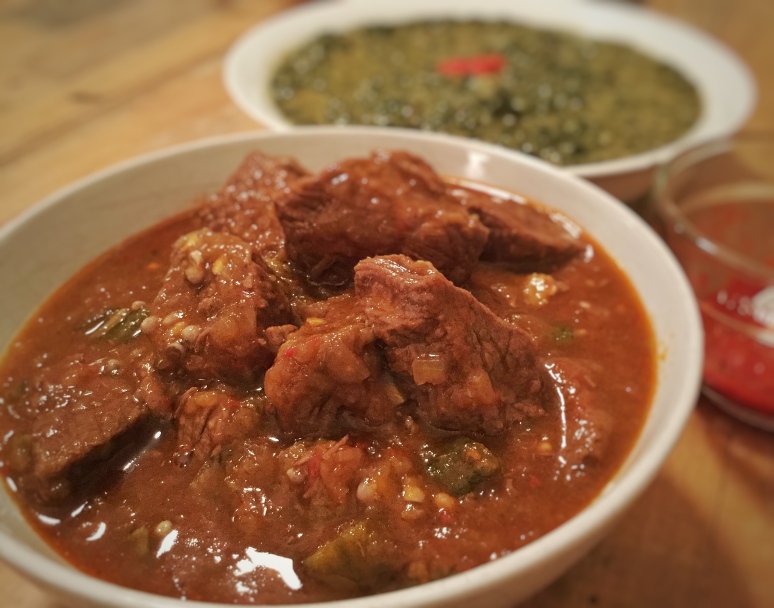
Can I tell you something? I have cooked some outrageously complicated dishes during the last few years of this blog – some were good, some were not. But this simple, honest stew? It was, without question, one of the most delicious things I have ever cooked. So simple and so tasty – rich, spicy, tongue-coating and tender. I couldn’t stop eating it. Please make it, seriously, you’ll love it.
I’m tempted to say the same thing about the next stew, which we’re calling “Spinach Stew” – despite being so simple, it is a rich, satisfying flavor blast, especially when taken with a bite of cassava fufu. Just take some spinach and chop it up really fine, or even grind it if you have a wet-grinder.
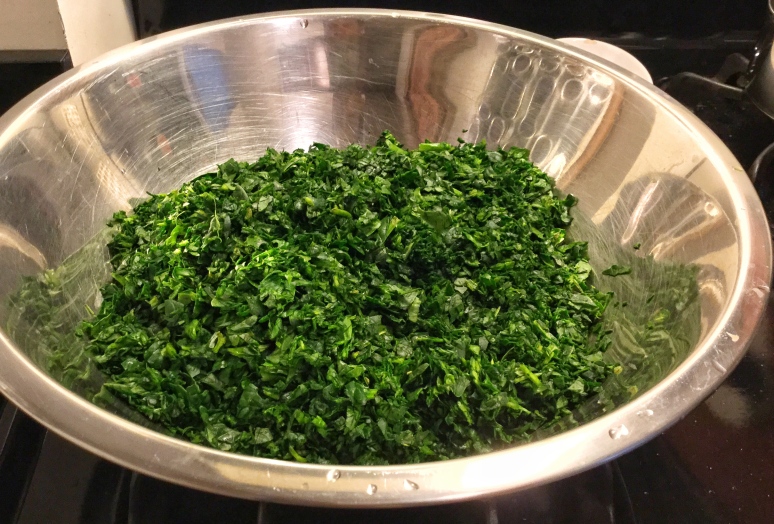
Then you just fry up some onion, then some tomato, then the spinach goes in along with more piment and natural peanut butter.
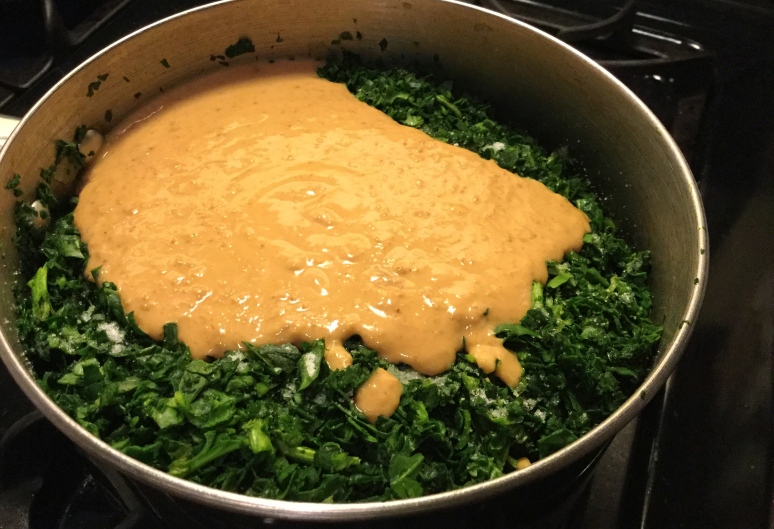
Twenty minutes later you are chowing down and realizing why folk wisdom says you are not supposed to chew your fufu – why take longer to get this into your gut than absolutely necessary? The flavors of peanut and spinach are born to be wed, and the savory glutamates in the tomatoes make a great maid-of-honor. The piment is the poorly-behaved ring-bearer, I guess.
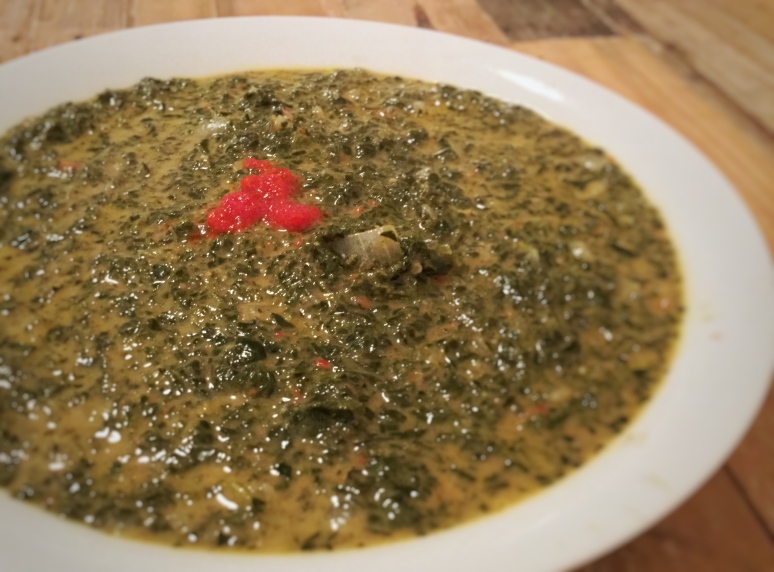
That little extra dab of piment was enough for me, but some people may want way more. In any case, you make it by just pureeing or mashing a scotch bonnet into paste, like so:

Keep going until it’s pretty liquid – you can add salt and splash of water if you need more grit or lubrication. Careful! It’s hot.
Finally, we need to make our fufu, or boule or kàm as it’s called in Central African Republic. La boule is pretty much the main component of a Central African meal, according to this kind of intense book I found at the Schomberg Center called Cuisine et nourriture chez les Gbaya de Centrafrique. The boule is never eaten alone, so you need something to go with it (stews, nut or seed pastes, piment etc.), plus it is also the utensil with which one consumes non-boule items.

I’ve made fufu a couple of different ways by now, but this time I opted to go for the easy way – fufu flour. It’s harder than it seems, though – I poured it into the water too fast, and it clumped a bit. Since it sets so quickly, there is no time to whisk out the lumps, so I will really have to learn some patience before the next time I try this.
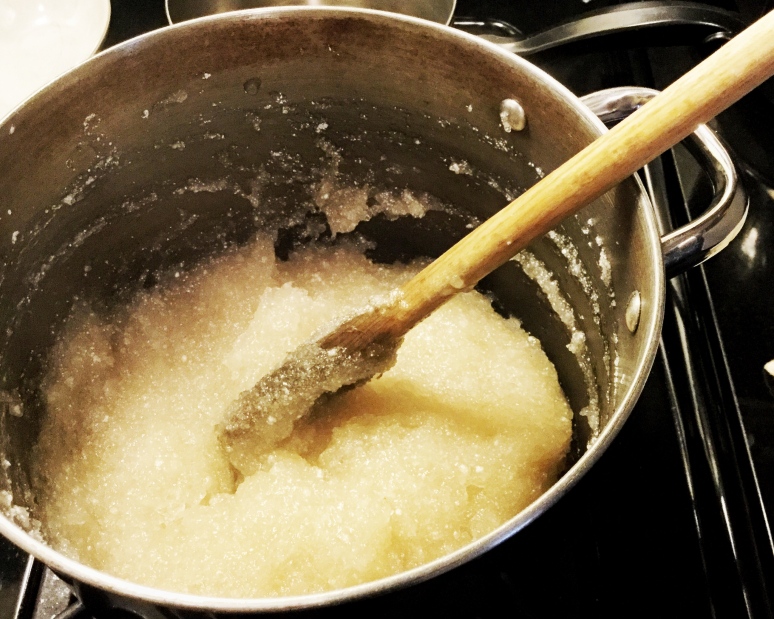
Regardless, I poured this starchy blob into a bowl that had some plastic wrap lining it, then closed up the wrap and let it cool for a little bit – that sets it into a boule-like shape, after which it can be turned out on a plate and unwrapped, like this:
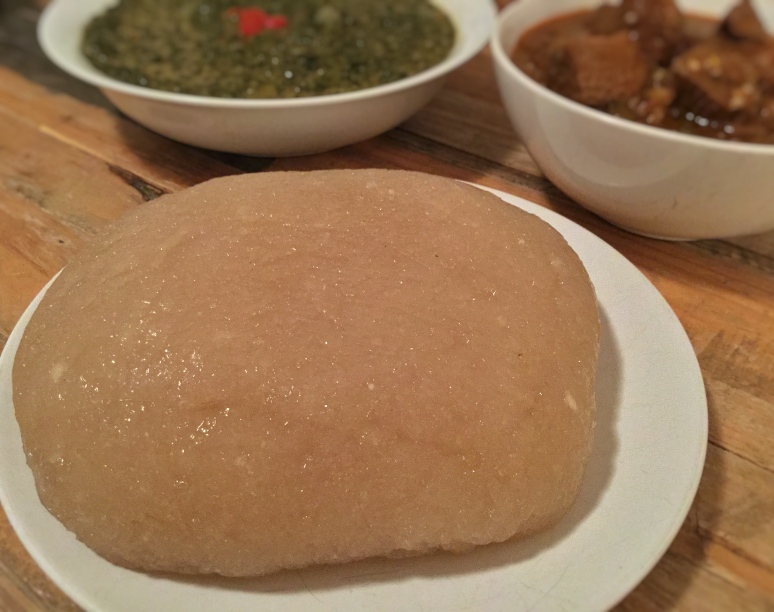
Then you just take a chunk with your fingers, form a little pad, and then scoop some stew onto it and, quickly and carefully, into your mouth:

You might be thinking, “dude, that’s not much stew you’re picking up there – you’re going to end up eating a lot of that fufu.” Well, you’re right – the boule is a quick-burning, highly-processed carbohydrate, full of calories and very filling, and also not very expensive. The stews are just there to make the fufu a little more interesting, since on its own it sort of just tastes like communion wafers. As that book on the Gbaya people mentioned above, the boule is the base of the meal.
So, are these “famous” recipes from this country? Well, yes and no – dishes like these are found all over Central Africa and don’t necessarily have a fixed name, precisely because they are so ubiquitous and so malleable. Instead, they are named for what is in them at any particular time – like “vegetable soup” or “garden salad.” Dishes like these are simply what people eat – nothing more, and nothing less. They are relatively immune to fetishization due to their mutability and dependence on seasonality (and availability). The 2016 Global Hunger Index just named Central African Republic the most impoverished country in the world, with over 76% of its inhabitants without sufficient nutrition – you can see, then, how following a recipe could often be a useless and impossible expectation. One cooks what one has, in a way that makes sense within the culture – and in Central Africa, that often means boiling.
Central African Republic, you have reminded me that simple dishes often taste the best. Your food speaks for itself, and thankfully is much louder than those voices that have tried to speak over it. Hopefully I have not made things any harder for you – I tried my best!
Now you go:
Boeuf aux gombos
1 ¼ lbs. stew beef, cut into 2-inch pieces
3 tablespoons peanut oil
2 yellow onions, thinly sliced
2 tbsp tomato paste
6 okra, washed and cut into 1-inch slices
salt
1 Scotch bonnet chili (capsicum chinense, anyway), seeded and pureed
Heat the oil in a Dutch oven and sear the meat over medium-high heat. When meat is browned, add the sliced onions and cook until also slightly browned. Add the tomato paste and some scotch bonnet paste (aka piment) to taste (or dried chili powder, if you prefer), salt lightly and cover with water.
Simmer, covered, over low heat for 2 hours.
Uncover, add the okra and simmer again, uncovered, for 30 minutes. Add water 1/4 cup at a time if the stew begins to dry out.
Serve with cassava fufu (aka “la boule”).
Spinach Stew
2 onions, finely chopped
2 tbsp palm oil
2 tomatoes, peeled and sliced
1 ½ lbs fresh spinach, very finely chopped
4 tbsp natural peanut butter
1 tsp salt
Piment (Scotch bonnet puree) to taste
Heat oil over medium and saute onions until soft.
Add the tomatoes, and after 1 minute add the spinach, salt and piment. Cover with a tight-fitting lid, reduce to a simmer and cook for 5-10 minutes, until the spinach is wilted.
Mix the peanut butter with ½ cup of warm water and form a smooth paste. Add this to the pot and continue cooking for 15 minutes, stirring frequently. Add water 1/4 cup at a time if the stew begins to dry out.
Serve on white rice or with fufu (aka “la boule”).
Cassava fufu
2 cup yucca flour (fufu flour)
4 cups water
Bring the water to a boil, then reduce heat and SLOWLY, SLOWLY GOD DAMMIT stir in the fufu flour. It should readily congeal into a lump – stir as long as you can until it is stiff enough for the spoon to stand up in it by itself, then removes from heat.
Transfer to a plastic wrap-lined bowl, then seal tightly in the wrap. Allow to cool for 5-10 minutes, then serve on a plate alongside stews and condiments.
Sources:
Roulon-Doko, Paulette. Cuisine et nourriture chez les Gbaya de Centrafrique. Paris: L’Harmatton, 2001.
Soeurs missionnaires du Saint-Esprit. La cuisine au pays du soleil: 750 recettes recueillies en Afrique noir, a Madagascar et aux Antilles. Issy-les-Moulineaux, France: Editions Saint-Paul, c1971.
https://fr.wikipedia.org/wiki/Cuisine_centrafricaine
https://en.wikipedia.org/wiki/Economy_of_the_Central_African_Republic
https://fr.wikipedia.org/wiki/Cuisine_africaine
http://www.healthy-life.narod.ru/wor_ek40.htm
http://www.recettesafricaine.com/sauce-epinard-gombo.html
http://www.diakadi.com/afriquecentrale/pays/centrafrique/kanda.htm
http://www.journaldebangui.com/article.php?aid=313
http://beafrikatimo.over-blog.com/2016/03/centrafrique-bangui-cuisine.html
http://books.openedition.org/irdeditions/1641?lang=en
http://www.afrik-cuisine.com/recettes/ragout-de-boeuf-aux-epinards-et-a-l-arachide
http://www.petitfute.com/p111-republique-centrafricaine/guide-touristique/c46396-cuisine-locale.html
http://lafeedescoquelicots.superforum.fr/t396-recette-centrafricaine-kanda
http://www.afrik-cuisine.com/recettes/gombos-au-boeuf
http://www.cuisineafricaine.org/details_recettes.php?idRecette=756&&idFamilles=7-boeuf-aux-gombos
http://www.recettesafricaine.com/sauce-epinard-gombo.html
https://halshs.archives-ouvertes.fr/hal-00511970/document
http://www.worldtravelguide.net/central-african-republic/food-and-drink
[https://youtu.be/gcV0zFzIEPE]
Republic of Cape Verde
Arrrggghhh 10 months have gone by. Darn it. I really wanted to pick up the pace here, but a combination of having too many hobbies and overwhelming perfectionism has stunted me again.
Before we get into the cuisine of Cape Verde, I want to talk a little bit about my research and writing process, in the hope of justifying the ridiculous lapses between these posts. I tend to start my research online, as you might expect; it’s easy, and there is usually an abundant amount of material – or so it seems at first. Once you start comparing the various recipes and sources, though – and especially for cuisines and countries that are less-known in the West – you tend to find that out of ten recipes, nine of them are exactly the same, and came from a common ancestor. Without fail, this root tends to be some Angelfire-era, all-text webpage that does not cite its original source, which makes me very uncomfortable. This is where my work begins to multiply exponentially.
Let’s take this present post as an example: I needed a recipe for cachupa, possibly the most cited “national dish” of Cape Verde. I find a whole bunch of cachupa recipes online, with maybe three distinct versions to be discerned among them. A huge majority of these recipes are from other people who are doing the same cook-around-the-world project, and who have for some reason unquestioningly relied on that Web-1.0 page of dubious origin. As I dig deeper, I then start Google-searching in the source language (Portuguese, in this case), and I start to find more versions of the recipe, which now need to be translated and converted from the metric system in order for me to compare them to the English-language versions. Lots of these recipes are found on message boards, and none seem to match the original versions that I have already found in English.
This is where I put the project down, drink a beer and go play guitar or read for a couple of months until I calm down.
Then I start all over again, this time beginning with published academic database searches – JSTOR, WorldCat, etc. I eventually find some source-language, published recipes for cachupa, but they also have to be translated and now I’m noticing that the Portuguese spoken in Cape Verde is not exactly the same as that which is spoken in Portugal. I start emailing friends and coworkers who speak Portuguese for help, but no one seems to be able to clear up the details (WTF is “grão,” for instance?). Emails to the Cape Verdean embassy go unanswered, as expected (for the record, no embassy has ever written me back, ever). And where am I supposed to find farinheira? Relatedly, what is farinheira??
Only so much can be done online. Eventually, after a physical trip to a Portuguese grocer in Connecticut and a quick, in-person confirmation of the murkier points of Cape Verdean cuisine, I am ready to finally start cooking.
For those playing along at home, this initial research stage already took me SIX MONTHS. Then I gotta find time to cook everything, take photos the whole time while chopping and stirring, edit the photos (badly), and then finally write some extremely engaging and relatable text, like this. So, yeah – that’s why only two of these get done per year. My methodology is definitely extreme, but I don’t think it’s fair or appropriate to just pick up my iPhone and say “Siri, find me a recipe for cachupa” and then cook the first ridiculous thing that comes up. That’s the whole point of this blog, actually – to NOT do that.
Anyway. Now that I’ve gotten that out of the way – hey guys, woooooooooo let’s cook some Cape Verdean food!
Since the dishes of this tiny West African island are essentially a fusion of Portuguese and African cuisine (punctuated by New-World ingredients), I wanted to be sure to hit some of the really unique highlights of what truly makes Cape Verdean food “Cape Verdean.” In that interest, we’re going to cook an octopus stew, some sweet-potato-empanada-sort-of-things that are stuffed with fresh tuna and chilies, and finally that legendary cachupa, a kitchen-sink soup that includes anything and everything that a family might have on hand. Because it takes a while to make, it’s usually reserved for special occasions like weddings, but because I am a lunatic I am just going to make it for lunch.
Cape Verde is also really famous for lobster, but come on, I’m not a god-damned Rockefeller over here. Let’s just relax. You wanna mail me a lobster, go ahead and I’ll cook it.

Now, octopus – THAT’s a poor man’s sea creature. The stew is called “Polvo à moda do Zé do Lino,” which took a tremendous amount of effort to translate. I speak reasonable Spanish and fluent Italian, so Portuguese has shown itself to be sort-of-understandable to me in a drunken, slurred kind of way. Despite that, some of the words there just didn’t make any sense to me; “polvo,” ok – octopus. “À modo,” “in the style of,” got it. “Zé do Lino?” What the hell is that? Why is it capitalized? And why do some versions of the recipe write it as “Zé de Lino”?? Oh god, here we go.
It turns out that in Portuguese “Zé” is short for “José” – ok, now we have a name, José do Lino, potentially “José from Lino.” Unfortunately, “Lino” is not a town that I could locate in Cape Verde, so it couldn’t be that easy. They do have a town called “Banana,” though, which rules.
At this point I begin to go desperately insane. I again ask all of my Portuguese-speaking contacts to look into this, but no one knows anything. My guy Bernardo even asked a friend from Cape Verde. No luck there. Like a reverse culinary Grinch, my ulcer grew three sizes that day.
I again started scouring the web using Portuguese keywords and eventually found an article that mentioned this dish – it was an interview with a respected Cape Verdean cookbook author named Maria de Lourdes Chantre, who wrote a book called, simply enough, Cozinha de Cabo Verde. The article I found had a parenthetical phrase after the title of the recipe, which stated “polvo à ‘Zé do Lino’ (guarda da casa que tinha na Baía das Gatas) [the guard of a house I had in Baía das Gatas]”… so, what? Is it really named after her security guard?? WHERE IS THIS TAKING ME?!?
I needed to see her cookbook for myself, but it’s long since out of print (of course), and a used copy goes for about $200 on Amazon. No, thank you. Luckily, the New York Public Library has a copy, so I dragged my ass up to Harlem to visit the Schomburg Center for Research in Black Culture. The staff there helped me out a ton and I managed to get copies of recipes for all of the dishes we are making in this post, and this time from a VERY reputable source. That night, finally, I slept like a baby, despite never having been able to definitively pin down the elusive Zé do Lino. I guess I’d make a really crappy private detective.
After all that work, there’s really not that much to this recipe – Zé do Lino must have designed this recipe so he could cook it while he was also guarding the house. Just throw the cut-up octopus into a pot, cook it until it leaks out all of its retained water, and then add some aromatics and simmer a while longer. It’s funny, an octopus cooking all by its lonesome sort of smells like potato salad for a while. The outer skin gives up its purple tint along with all of its water, and turns everything else in the pot indigo. Once you add the onions and chilies, though, it starts to really meld into a more appetizing mixture.
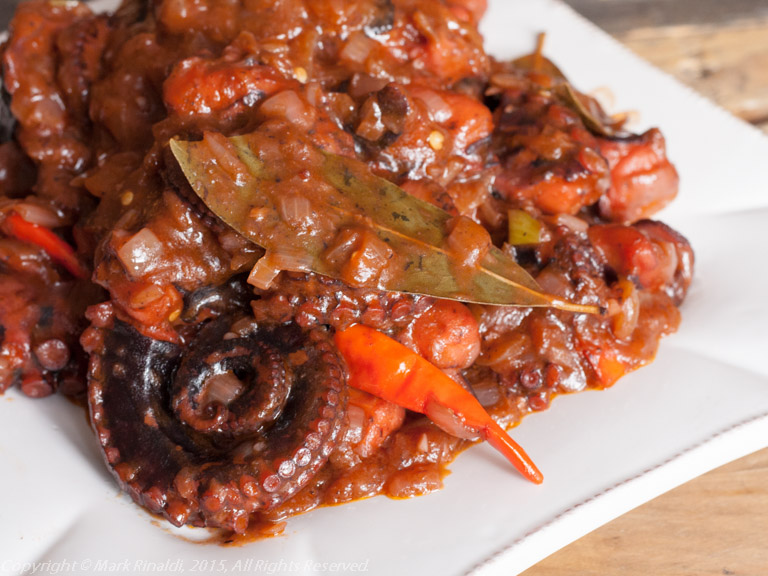
This dish is really not much of a stew, since you never actually cook with any added liquid. Instead, it’s more like a confit that is seasoned with onion, tomato, chilies and olive oil. Really very easy and kind of foolproof, which is welcome when cooking something as temperamental as a cephalopod. De Lourdes Chantre suggests that this dish, and really any fish or meat stew, be accompanied by pirão, a polenta-like porridge made from yucca flour, rendered salt pork and onion. Mine came out a little lumpy, unfortunately – next time I will whisk harder:
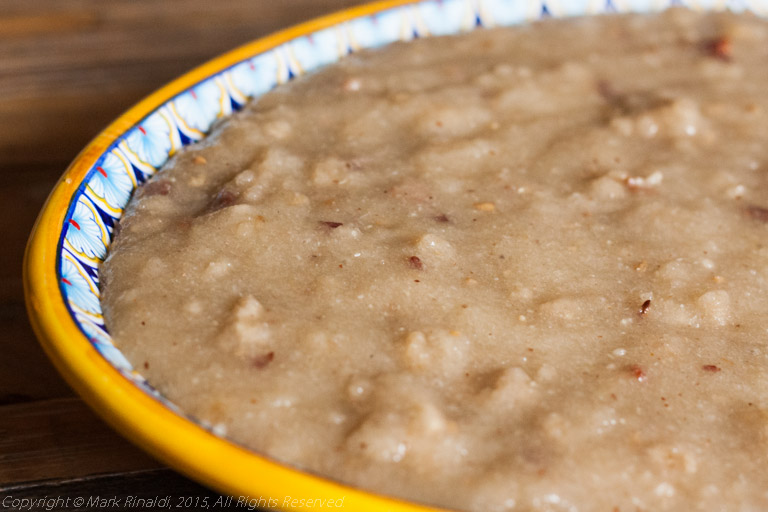
I’ll warn you now, the next couple of dishes require a lot of work, but they are very much worth the time it takes to prepare them.
Pastel com diabo dentro, or “pastry with the Devil inside,” made me so, so happy. This is exciting, I love a dish like this – it’s such a familiar concept but unique and hyper-local in its components. The flavors – tuna, chilies and starch – occur together in lots of Italian dishes as well, and weirdly reminded me of my staple diet of spaghetti, tuna and chilies when I was studying in Florence.
The process is basically this: mince up some fresh tuna and saute it with onions and chilies. Then make a dough of mashed sweet potatoes and cornmeal, and fill little packets of this dough the tuna mixture. Then deep fry the pastry packets and serve with more chilies. It’s your basic empanada or pastel recipe, but with a Cape-Verdean mindset and ingredients.
But waaaaait, wait wait – what exactly do we mean by “sweet potato”? We’ve been through this exhausting distinction before, but for the benefit of those who are just joining us, let’s review. The term “sweet potato” is chronically misused, or rather overused. It can encompass several potatoey members of different genera, and leads to all sorts of confusion. The orange-fleshed, brown-skinned sweet potatoes that we know in the U.S. are part of the variety of tuber known botanically as ipomoea batatas, although this genus also includes other tubers that are genetically similar but have different colored flesh and skins. I’ll tell you one thing, it is sure as shit not the same thing as a “yam,” which comes from the dioscorea genus and includes things like igname and nagaimo. The misapplication of the terms “yam” and “sweet potato” for the same vegetable have given me chronic migraines, so it’s important to know the difference when you are trying to be sensitive to context of the cuisine that you are studying.
In the case of our diabolical empanadas here, I wasn’t sure at first. The Caboverdean recipe listed “batata doce,” and searches for images of “batata doce” and “cabo verde” almost exclusively yielded photos of the brownish-skinned, pale-orange-fleshed variety that are easy to get in the U.S. A few others showed a pale yellow or even white skin, with white flesh. Which to use? My options were the American sweet potato and the boniato/batata/white sweet potato from South America, which is drier and less sweet than the orange variety, but also less dense in texture. Both are part of ipomoea batatas, so either would probably work, and both seem to appear in the Cape Verdean culinary lexicon.
Looking at photos of the finished “pastel com diabo dentro” in Google image search, I noticed that basically all of them have a strong, yellow-orange hue – too dark to have gotten this hue from just cornmeal. I went with the readily-available and botanically-correct American sweet potato. If anyone from Cape Verde reads this and knows I am wrong, just let me know and I will cook it all over again.
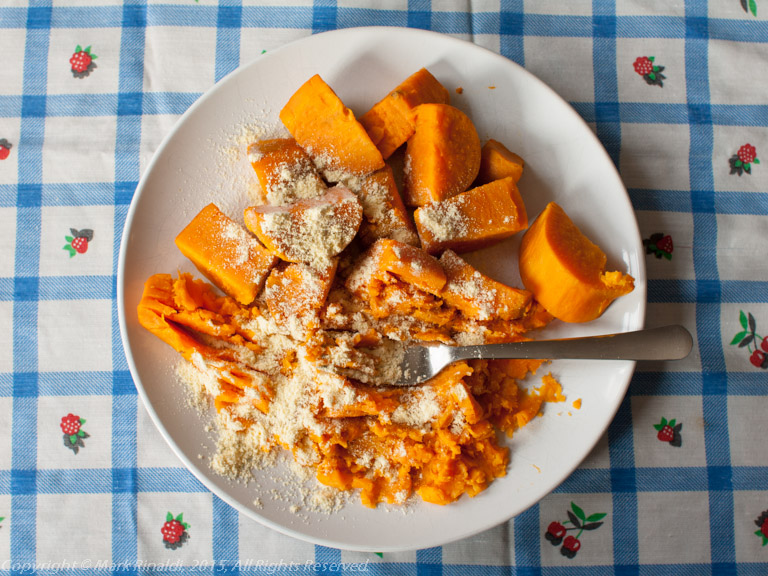
What you do is just boil the sweet potatoes and mash them with the cornmeal. Knead for a bit, and you’ll end up with a moist, slightly sticky dough.Once that is ready, wrap it in plastic and refrigerate it for a while, to make it easier to work with. While that cools, you can prepare your filling, which is dead simple – just marinate some chopped tuna with onion, garlic, vinegar and malagueta, a red, extremely hot chili in the capsicum frutescens genus.
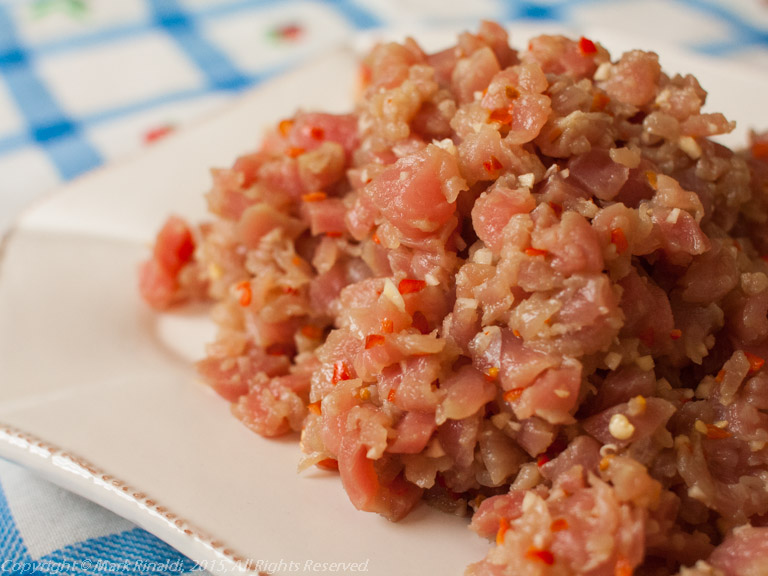
Eventually, this mixture will get a quick saute and then be left to cool, before being stuffed into rounds of rolled out sweet-potato dough.
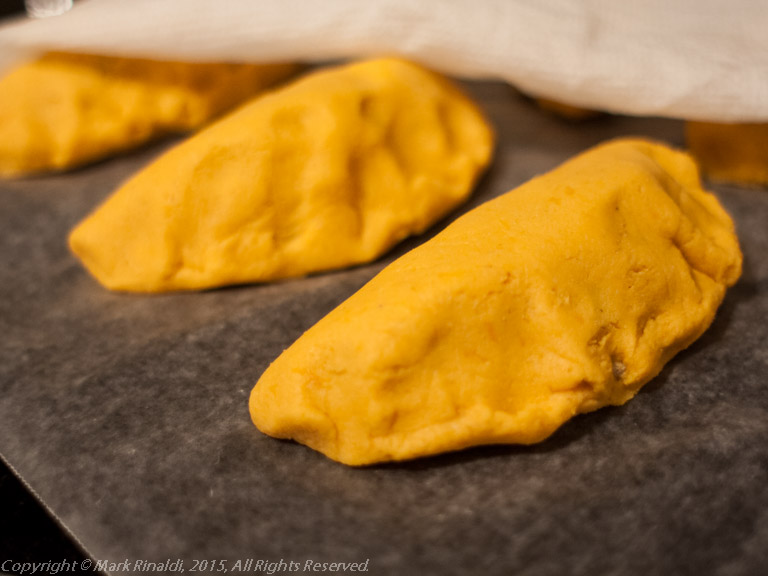
These packets get a hot, quick fry in oil or lard and come out steaming, with a crisp crust that slowly softens into a warm mealiness as they cool. Best to enjoy them hot, right out of the fryer.

I need you to hear this: THESE ARE BEYOND DELICIOUS. Of all of the dishes I have cooked for the blog so far, this one is in the top three, for sure. The sweet-potato-cornmeal dough made me think of a corn dog when it first hit my teeth – crisp, sweet, dense and substantial, with a hit of that smoking hot, I’m-having-fun-at-the-county-fair fry oil smell. Then, the acids from the vinegary tuna start to creep out, and finally the chilies hit your tongue, activating every zone of your taste buds at once. I was blown away by how good these were, and I ate way too many of them at once. It reminded me just a little of brik, a North-African phyllo packet stuffed with tuna and an egg and deep fried.
If I made them again and felt like changing the traditional recipe for my own taste, I would just leave the tuna mixture raw when packing it into the dough – a little rare is fine with me, and might have kept the filling juicier. Overcooked tuna can get a little chalky.
OK, let’s make our last dish, the famous cachupa rica – don’t worry, you only need a few ingredients:

Hahahahahahahahahahahahahahah just kidding it’s a huge pain in the butt. You’re going to need a ton of hard-to-find stuff and it makes enough food for like ten people, even after scaling it down. Seriously, don’t even try to cook this, just go to Cape Verde and eat it there, it will be easier.
This dish was an immense challenge, especially because there was very little specific guidance to be found. Not unexpectedly, pretty much all of my global-cooking compatriots seem to have taken the easy way out and done the diminutive cachupinha [“little cachupa“] version of this dish (a much simpler soup of fresh corn and sausages) or used a reprehensible amount of substitutions, so I had to be the one to do the whole shebang. It’s fine, no, really, I’ll do all the hard work. Thanks guys.
Let’s take apart what we’re working with here. At it’s core, cachupa is a continued iteration of the Caboverdean reliance on corn as a main staple, a vestige from the island’s role as a way-station between the New World and Africa during the Atlantic slave trade. While probably uninhabited prior to Portuguese settlement in the mid 1400s, Cape Verde was later used to cultivate numerous non-native, New-World crops such as corn, chilies and tomatoes. Cachupa is a literal melting pot of all of these ingredients, along with native foods such as plantains, cassava and igname, a decidedly Portuguese measure of salty pork.

These pork products are distinctly Iberian – aside from the salt pork/bacon in front, from left to right we have morcela (made from pig’s blood), farinheira (a smoked sausage made with wheat flour), chouriço (made with smoked dried peppers) and linguiça (a fresh pork sausage).

Grains are also a big part of cachupa rica, the translation of which caused me some vexation as well. Some were easy – feijão manteiga translated easily as lima beans. OK, no problem there. The mind-bending “grão” did eventually give itself up as none other than the humble chickpea, a fact that was confirmed by the nice gentleman at Wayside Market in Waterbury, Connecticut (my hometown, and home to a large Cape Verdean community), where I miraculously found all of the ingredients that had previously eluded me. A new one that I thought I had never seen before was feijão pedra, or “rock bean,” but some research showed that this was actually our old friend the lablab bean, which we encountered during my post on Burma. There, they were fried until crisp. Here, they are getting stewed along with everything else (especially because I found out the raw beans are poisonous – whoops!). And of course, corn once again takes center stage, in the form of semi-crushed grains of corn, commonly called samp.
OK, so first you get your chicken – wait, did I mention there’s a chicken? There’s a chicken. You have to cook a chicken, too, as a side dish. Yes, a side dish to the stew. I know, it didn’t make any sense to me either – I sort of assumed from the pictures I had seen and the descriptions I had read that this was a one-pot stew, with a ton of stuff in it. But really, it’s an assembly of three separate dishes – a bean-and-sausage stew, a braised chicken and some boiled veggies. Serving them all separately but at the same time was not what I pictured, but it is smart – it keeps all of the flavors distinct. Cooking so many ingredients together would mean that you end up with a muddy, bland pap. This was way, WAY better.

The chicken gets simmered with tomatoes, onions and – you guessed it – chilies, with a little water added to make a thick sauce. The vegetables, on the other hand, get boiled with a little rendered salt pork and then drained.
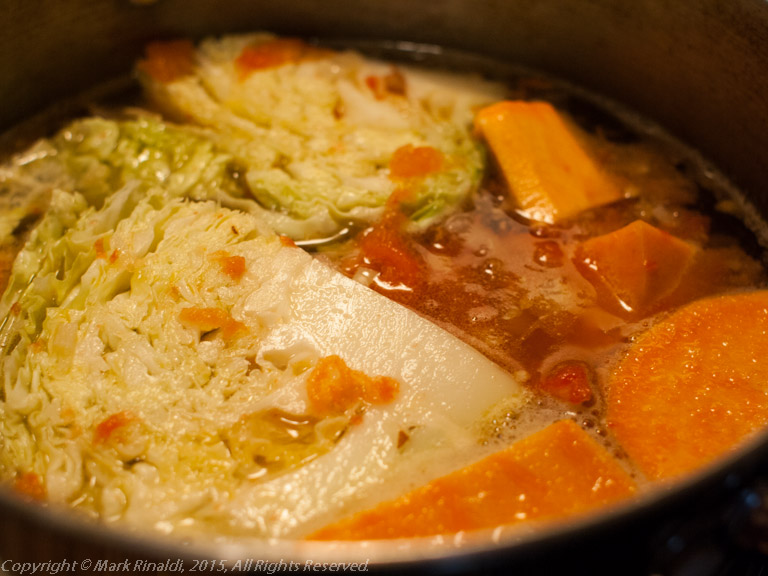
So how does this all taste? The sausages each have their own personalities; the morcela is cakey in texture and tastes strongly of cumin and iron, as you might expect; the linguiça is fleshy and porky, like conventional or Italian sausage; the chouriço is smokey and fatty, with big bits of lard lolling around in each bite; and the farinheira was the newest to me – I had never heard of it before this. I lost one in the stew, since it split open when the flour inside of it expanded to about four times its original size. I lowered the heat for the other one (always buy a spare!!) and it held together nicely. It has a lighter, sweeter, less aggressive flavor than the more macho smoked sausages, and the texture is very soft and bready. I guess if you crossed sausage with a boiled Eastern-European bread “dumpling” you’d sort of get the idea.
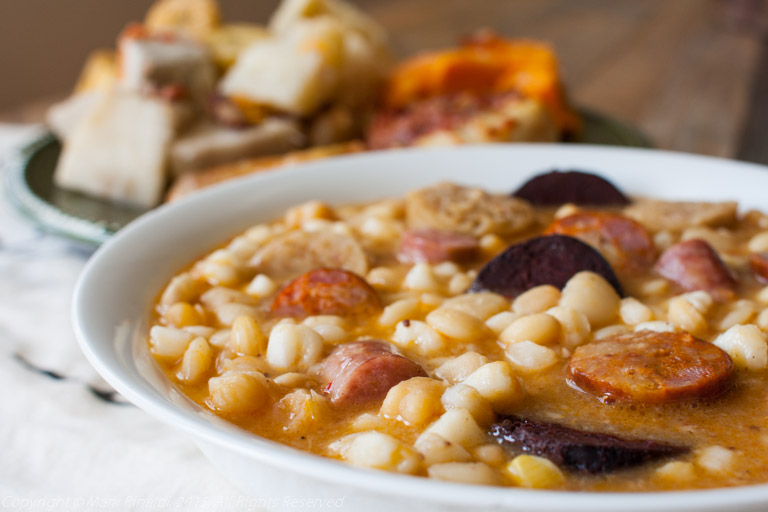
Cape Verde, you have astounded me with your bounty. You take everything you have, old and new, and use it harmoniously and deliciously. Thanks for showing me an exciting and delicious cuisine that deserves a lot more attention than it gets. Oh, and your cosmic disco is pretty awesome, too.
Now you go:
Note: the following recipes are all translated and adapted from Cozinha de Cabo Verde by Maria de Lourdes Chantre
Polvo à moda do Zé do Lino (Octopus in the style of Zé do Lino)
2 lbs. octopus
2 bay leaves
4 tablespoons of olive oil
2 very ripe tomatoes, chopped, or l tablespoon of tomato paste
2 cloves of garlic, mashed or minced
l large onion, finely chopped
3-4 piri-piri chilies, whole or minced
Wash and remove the ink sac from the octopus, preferably in sea water. Beat the octopus very well (presumably with a stick or against a rock) to make it “tender.” Cut the octopus into bite-sized pieces and place it over low heat it in a pan with the bay leaves and 3 tbsp of olive oil.
When all of water that it releases has evaporated (after about 15 minutes or so), add the chopped tomatoes (or tomato paste), chopped onion, mashed garlic cloves, the chilies and another tbsp of olive oil.
Continue cooking over low heat, stirring constantly, until the garlic and onions have softened and any remaining liquid has reduced into the thick sauce. Adjust for salt and serve.
Pirão
1 lb. yucca flour
1 small onion, minced
1/4 cup olive oil
1/4 lb. fresh salt pork, finely chopped
salt to taste
boiling water (twice as much as the volume of the yucca flour)
In a medium-sized pot, combine the olive oil, salt pork and minced onion. Let them brown over low heat.
Once the onions are soft and the pork has rendered fully, add the yucca flour and boiling water. Mix well with a whisk and bring to a boil, stirring constantly to prevent sticking or burning. Stir until any lumps have broken apart and the pirão has thickened dramatically and just started to adhere to the sides of the pot (think: polenta).
Remove from heat and serve immediately, with octopus stew or any other fish or meat stew.
Pastel com diabo dentro (Pastry with the Devil Inside)
1 lb. sweet potatoes
2 cups fine cornmeal
½ lb fresh tuna
1 medium white onion
1 tbsp olive oil
1 clove garlic, minced
6 red chilies, minced
1 splash (“gulp”) white vinegar
1 tsp (“modicum”) tomato paste (optional)
Salt
Oil for frying
Filling:
Mince the tuna and season with salt, chilies, garlic and vinegar, and set aside to marinate while you prepare the remaining ingredients.
Slice the onion thinly and place them in a frying pan with the 1 tbsp of olive oil, adding the tomato paste if desired and frying until they are soft and lightly browned.
Add the tuna mixture to the pan and let it simmer until the tuna is just cooked through. Remove from heat and let cool completely.
Wrapper:
Peel and boil the sweet potato in well-salted water until it is soft. Mash it thoroughly, adding 1 tsp salt and handfuls of cornmeal until it forms a cohesive ball of dough. Pull off golf-ball-sized chunks of this dough, and flatten them on a piece of plastic wrap to form thin discs about 4-5 inches in diameter.
Take each disc and place 2 tbsp of filling in the center. Fold the disc in half and seal the edges very well. Store the formed packets on wax paper until you have used up all of the filling.
Fry the packets in small batches in a deep pot (or individually, if the pot is small) in very hot oil until they are golden brown. Serve hot!
Makes 9 packets.
Cachupa Rica (scaled down to 6-8 servings)
2 cups dried cracked hominy (samp [milho cuchido])
1/2 cup small dried chickpeas (grão)
1/2 cup dried stone/hyacinth/lablab beans (feijao pedra)
1 cup dried lima beans (feijao-manteiga)
1/2 pound fresh pork sausage, uncut (linguiça)
1 smoked pork sausage, uncut (chouriço)
1 smoked blood sausage, uncut (morcela)
1 farinheira sausage, uncut
3/4 lb chicken parts
1/16 pound salt pork, sliced
1/2 large onion, sliced into rings
2 garlic cloves, peeled and finely chopped
1/2 pound firm tomatoes, seeded and quartered
1/2 small Savoy cabbage, one whole quarter
1/2 pound sweet potatoes, peeled and cubed
1/2 pound yucca, peeled and cubed
1/2 pound igname, peeled and cubed (dioscorea alata)
1/2 pound green plantains, peeled and sliced 1 inch thick
1/2 teaspoon salt
Olive oil, as needed
Red chilies, to taste
Place hominy, chickpeas, and stone and lima beans in a large pot, add water to cover, and soak overnight in refrigerator (this prevents fermentation). The following day, drain everything, rinse well, and once again add cold water to cover. Bring to a boil, reduce heat, and simmer 1 hour. After 1 hour, add whole sausages to mixture and simmer 1 more hour, or until beans are tender.
While the beans cook, season chicken with salt and crushed red pepper and set aside. In a large pan, heat the olive oil. Add onions and garlic and simmer until onions are transparent. Add tomatoes and simmer 5 minutes. Remove half of the tomato-onion mixture and place in a pot with the chicken pieces and 1/2 cup of water. Bring to a boil, then simmer until chicken is tender, approximately 30 minutes, adding more water as necessary to keep a little sauce in the pot.
In another large pot, cook sliced salt pork until fat cooks out. Pour off all but 1 tablespoon fat. Add sweet potatoes, yuca, igname, cabbage and the remaining tomato/onion mixture to the pot, with enough water to barely cover. Simmer until vegetables are tender, 25 to 30 minutes, adding more water if mixture begins to stick. Add plantains during last 5 minutes of cooking.
To serve, remove sausages from beans and cut into 1-inch pieces. Return sausages to bean pot. Place the beans and meat mixture in a soup tureen or a large deep dish. Serve the vegetables on a large platter, and the chicken in a deep covered dish.
SOURCES
http://www.elsgnoms.com/receptes/cabo_verde78.html
https://easyportugueserecipes.com/category/others/page/6/
https://en.wikipedia.org/wiki/Farinheira
https://pt.wikipedia.org/wiki/Phaseolus_lunatus
http://www1.umassd.edu/specialprograms/caboverde/cachupa.html
Click to access Cape%20Verde.pdf
http://westher.home.xs4all.nl/recepten/CACHUPA%20RICA%20%28in%20English%29.htm
http://www.caboverde.com/rubrique/gastro-e.htm
https://capeverdeinlondon.wordpress.com/2010/03/15/whats-the-big-deal-about-making-cachupa-rica/
http://www.gastronomias.com/lusofonia/cv005.htm

